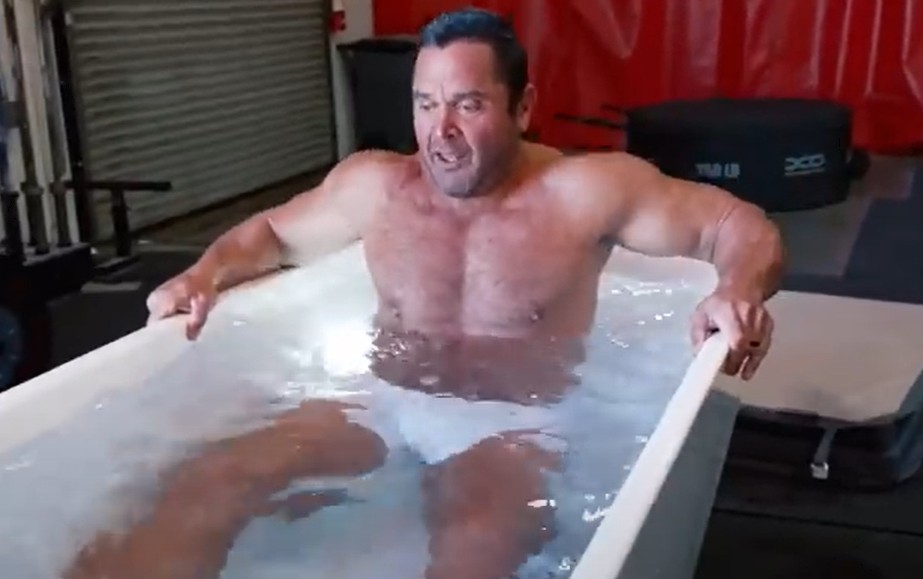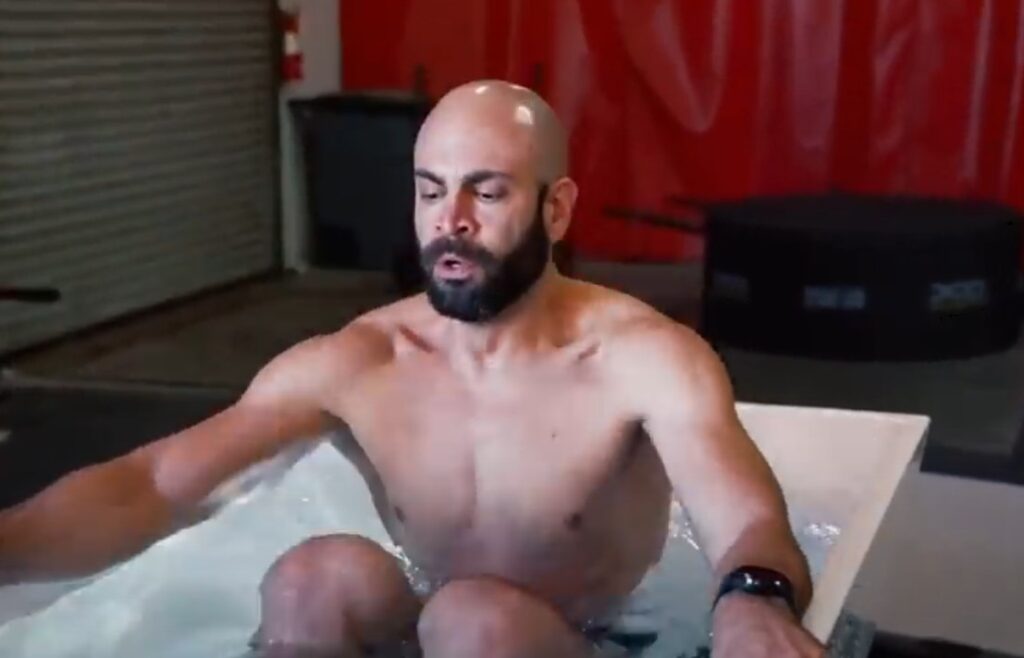Need help?
Unsure whether you need a bath or a plunge, portable or fixed, chiller or iced? Check out Sasha’s cold plunge vs ice bath article to answer all and get clarity on your cold immersion needs.
Imagine stepping into a pool of icy water. Your breath catches, your muscles tense, and your mind suddenly feels razor-sharp, all distractions vanishing. You may have heard about cold plunge experiences from professional athletes – those intimidating, yet incredibly rewarding sessions that involve immersing yourself in water at temperatures most people would avoid. If you’ve ever wondered why athletes swear by them, or if you’re curious about trying it out yourself, this guide is for you.
Contents
- 1 Why Cold Plunges?
- 2 Athletes and Their Cold Plunge Stories
- 3 Your Cold Plunge Setup
- 4 How to Cold Plunge Like a Pro
- 5 What to Expect: The Ups and Downs
- 6 Product Recommendations for Your Plunge Journey
- 7 More Than Just Physical Recovery
- 8 Cold Plunge Alternatives
- 9 Safety First
- 10 Your Cold Plunge Journey Begins
Why Cold Plunges?
Cold plunges are about more than just toughening up; they offer remarkable health benefits. Athletes like LeBron James, Cristiano Ronaldo, and elite marathon runners have embraced cold water immersion as a regular part of their recovery routines. It may sound daunting at first, but there are good reasons why these top athletes willingly dive into freezing waters.
When you plunge into cold water, your body goes through a series of changes. First, the cold water constricts your blood vessels, reducing inflammation and promoting faster recovery. As you warm up afterwards, your vessels expand again, flooding your body with freshly oxygenated blood. This process helps flush out lactic acid and other waste products, leaving your muscles feeling refreshed and renewed. If you’re looking for a way to ease post-workout soreness, improve circulation, or even boost your mood, a cold plunge might just be the missing piece of your wellness puzzle.
Athletes and Their Cold Plunge Stories
Take the case of Russell Wilson, NFL quarterback, who attributes part of his peak physical condition to the use of cold plunges. He often uses an ice bath to reduce inflammation after intense games. Serena Williams, too, has mentioned that ice baths help her stay at her best, especially during tournaments where recovery time is critical. These athletes rely on cold plunges not just because they’re trendy, but because the benefits are tangible: reduced muscle soreness, faster recovery, and even better sleep.
You might also hear about Wim Hof, the “Iceman,” who’s known for his incredible feats of cold endurance. While not strictly an athlete, Hof has inspired countless pros to incorporate cold exposure into their training regimens. His approach combines breathing exercises with cold exposure to help improve both physical and mental resilience. If you’re new to cold plunging, following a version of his breathing techniques can help you manage the initial shock of icy water.
Your Cold Plunge Setup
Before you jump into your own cold plunge experience, you’ll need to make some preparations. While professional athletes have access to state-of-the-art cold plunges, you don’t need to spend a fortune to get started. Here are a few budget-friendly ways to create your own cold plunge setup at home:
- Bathtub Ice Baths
- The simplest way to start is by using your bathtub. Fill it with cold water and add a couple of bags of ice. You can start with short immersions – just one or two minutes at first – and gradually work your way up as your tolerance increases.
- If you want to make this process a bit easier, consider using an ice maker like the GE Profile Opal Countertop Nugget Ice Maker (available on Amazon). It’s a favorite among home cold plunge enthusiasts because it produces chewable nugget ice that chills your bath quickly.
- Portable Cold Plunge Tubs
- If you’re looking for something a little more dedicated, you might want to try a portable ice bath. Check out Marcus’s definitive top list for portable ice baths so you don’t get a dud.
How to Cold Plunge Like a Pro
When you’re ready to give cold plunging a shot, there are a few tips to keep in mind to make the experience more manageable and beneficial:
- Start Small: Your first plunge doesn’t need to be a marathon session. Begin by spending just one or two minutes in the cold water. Many athletes recommend gradually increasing the time as you become more comfortable.
- Control Your Breathing: The initial shock of the cold can make you feel like you can’t breathe. To combat this, try practicing slow, deep breaths. Focus on exhaling longer than you inhale to calm your nervous system. This is a trick that many pro athletes use to stay relaxed during cold plunges.
- Stay Consistent: The benefits of cold plunging come with consistency. Rather than doing a single 10-minute plunge once a week, aim for shorter, more frequent sessions. Professional athletes often make cold plunges part of their daily routines, even if it’s just for a few minutes.
- Use the Right Gear: Sometimes, the small details make a big difference in your cold plunge experience. Our favorite pair of neoprene gloves and booties can help keep your hands and feet warm, making the plunge a bit more bearable in the beginning.
What to Expect: The Ups and Downs
Cold plunging isn’t always easy. You’ll likely face moments of doubt and discomfort, especially when you’re just starting out. However, with time, you’ll begin to notice the benefits. Many athletes report that a cold plunge provides a sense of calm and clarity that’s difficult to achieve through other means. The immediate boost in endorphins leaves you feeling energized, while the reduced muscle soreness means you can train harder, for longer.
Expect that the first few times might be tough. Your body will fight it, and your mind might scream at you to get out. But if you stick with it, you’ll notice that your body starts to adapt. You’ll be able to stay in the water longer, and the shock of the cold will diminish. This adaptation is part of the cold plunge experiences from professional athletes that they love – it’s a physical and mental challenge that leads to growth.
Product Recommendations for Your Plunge Journey
- Thermometer/Timer: To ensure you’re hitting the right temperature, consider picking up a waterproof thermometer. The Suomik ice bath thermometer with built in timer is a versatile choice that’s popular among cold plungers. It helps you maintain the water temperature at an optimal range (usually between 50°F and 59°F).
- Post-Plunge Comfort: Once you’re done with your cold plunge, having a warm robe or towel nearby can make the experience much more pleasant. A favorite among athletes for its warmth and comfort is the Speedo Parka, perfect for post-plunge coziness.
- Recovery Drinks: Cold plunges pair well with good hydration. Athletes like to follow their sessions with an electrolyte-rich drink to aid recovery.
More Than Just Physical Recovery
Cold plunges are not only about physical recovery; they’re also powerful for your mental health. Many cold plunge experiences from professional athletes talk about the mental resilience they build through consistent cold exposure. Stepping into cold water when every fiber of your being wants to stay warm teaches you how to overcome discomfort, manage stress, and push through challenging moments. This mental fortitude can translate into other areas of your life, making you more adaptable and resilient.
UFC fighters like Aljamain Sterling have spoken about the psychological benefits of ice baths, emphasizing how they help him keep his focus sharp. Enduring the cold builds discipline – it trains your mind to remain calm and resilient, even when you’re facing discomfort or fear. If you’re dealing with a lot of stress or anxiety, regular cold plunging could provide a natural way to train your mind and body to stay grounded in difficult situations.
Cold Plunge Alternatives
If a full plunge still feels too intimidating, there are other ways to get started. Cold showers can be a great introduction to cold exposure. Start with your usual warm shower, and then gradually turn the temperature down to as cold as you can handle for the last 30-60 seconds. This method is used by athletes who are traveling or don’t have access to a full plunge setup.
You can also try contrast therapy, which involves alternating between hot and cold. Many professional soccer players use this approach, as it offers the benefits of cold exposure while still allowing moments of warmth. You could set up two tubs – one hot and one cold – or simply alternate between hot and cold water in the shower. Contrast therapy can be especially effective for reducing muscle fatigue and boosting circulation.
Safety First
While cold plunges can be highly beneficial, it’s important to approach them safely. Don’t push yourself too hard too soon. If you have any cardiovascular issues, consult your doctor before trying cold plunges, as the sudden drop in temperature can strain your heart. Always listen to your body, and if you feel dizzy or extremely uncomfortable, it’s okay to get out. Professional athletes are surrounded by trainers who monitor their recovery, so it’s crucial to know your limits when you’re on your own.
Your Cold Plunge Journey Begins
If you’re ready to take the plunge – literally – you’ll be joining a community of athletes, wellness enthusiasts, and adventurers who have discovered the powerful benefits of cold exposure. Whether you’re looking to reduce soreness, boost your mental resilience, or simply try something new, cold plunging could be the answer. Remember, the key is consistency and patience. It’s a journey that’s as much about mental growth as it is about physical recovery.
So go ahead, grab some ice, set up your plunge, and see for yourself why professional athletes are embracing the chill. Your body – and mind – may thank you for it.
This website may contain affiliate links. As an affiliate, we may earn a commission from qualifying purchases at no additional cost to you.


